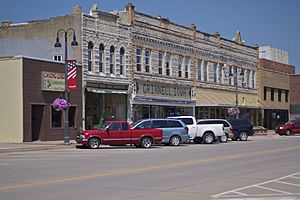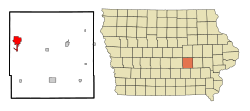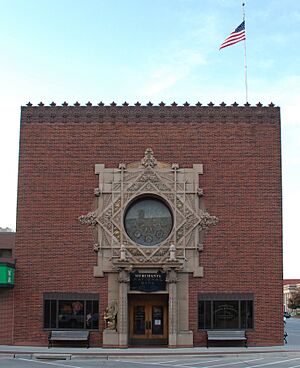Grinnell, Iowa facts for kids
Quick facts for kids
Grinnell, Iowa
|
|
|---|---|

Downtown Grinnell
|
|
| Motto(s):
"Jewel of the Prairie"
|
|

Location of Grinnell, Iowa
|
|
| Country | |
| State | |
| County | Poweshiek |
| Area | |
| • Total | 5.73 sq mi (14.84 km2) |
| • Land | 5.69 sq mi (14.74 km2) |
| • Water | 0.04 sq mi (0.11 km2) |
| Elevation | 1,014 ft (309 m) |
| Population
(2020)
|
|
| • Total | 9,564 |
| • Density | 1,681.14/sq mi (649.06/km2) |
| Time zone | UTC−6 (Central (CST)) |
| • Summer (DST) | UTC−5 (CDT) |
| ZIP Codes |
50112, 50177
|
| Area code(s) | 641 |
| FIPS code | 19-33105 |
| GNIS feature ID | 0457150 |

Grinnell is a city in Poweshiek County, Iowa, United States. In 2020, about 9,564 people lived there. Grinnell is well-known for being the home of Grinnell College. It also has the Merchants' National Bank building, which was designed by the famous architect Louis Sullivan.
Contents
Discovering Grinnell's Past
Grinnell was started in 1854 by settlers from New England. These settlers were descendants of English Puritans from the 1600s. Four men founded the city: Josiah B. Grinnell, a minister named Homer Hamlin, a surveyor named Henry Hamilton, and Dr. Thomas Holyoke. They first thought of naming the city "Stella." But Josiah B. Grinnell convinced them to use his name, saying it was unique and short.
Grinnell officially became a city on April 28, 1865. By 1880, about 2,000 people lived there. The city grew because it was located where two important railway lines met. These were the east-west line of the Rock Island Railroad and the north-south Minneapolis and St. Louis Railway. This made Grinnell the biggest community in Poweshiek County.
Grinnell's Role in the Underground Railroad
From its very beginning, Grinnell was a stop on the Underground Railroad. This was a secret network that helped enslaved people escape to freedom. A famous event happened in February 1859. The abolitionist (someone who wanted to end slavery) John Brown and 12 enslaved people he was helping stayed with Josiah B. Grinnell and other people in the community. Because of Josiah B. Grinnell's efforts to help end slavery, his gravesite is now part of the National Underground Railroad Network to Freedom.
The Mormon Trail Near Grinnell
The Mormon Trail passed along the southern edge of Grinnell. This trail was used by over 100,000 travelers between 1846 and 1869. About 70,000 of these were Mormons who were escaping religious persecution. The first group of pioneers set up the route from Nauvoo, Illinois, to Salt Lake City. Today, a stone marker remembers the Mormon Handcart Trail and the grave of a child who died along the trail near Grinnell.
Early Challenges and Growth
Grinnell is home to Grinnell College, a private college that started in 1846. The city faced two big challenges in its early years. On June 17, 1882, a very strong tornado hit Grinnell. It destroyed most of the college campus and a lot of the city. Sixty-eight people died, and the damage cost about $1.3 million (in 1882 money). In June 1889, a large fire also destroyed most of the downtown area.
Grinnell was also home to the Spaulding Manufacturing Company. H. W. Spaulding started making carriages in Grinnell in 1876. In 1909, the company began making cars. At one point, this factory was the largest employer in the county. But Spaulding stopped making cars in 1916 because they couldn't compete with the cheaper Ford cars. The old Spaulding factory site is now home to the Spaulding Center for Transportation/Iowa Transportation Museum. It also has apartments.
Grinnell's Location and Weather
Grinnell covers about 5.64 square miles (14.6 square kilometers). Most of this area is land, with a small amount of water.
Grinnell's Climate
Grinnell has a humid continental climate. This means it has hot, humid summers and cold, snowy winters. On average, it rains about 38.19 inches (970 mm) each year. Summers are the wettest time of year, with most of the rain falling between April and September.
| Climate data for Grinnell, Iowa, 1991–2020 normals, extremes 1893–present | |||||||||||||
|---|---|---|---|---|---|---|---|---|---|---|---|---|---|
| Month | Jan | Feb | Mar | Apr | May | Jun | Jul | Aug | Sep | Oct | Nov | Dec | Year |
| Record high °F (°C) | 64 (18) |
74 (23) |
90 (32) |
92 (33) |
107 (42) |
105 (41) |
108 (42) |
110 (43) |
101 (38) |
95 (35) |
82 (28) |
69 (21) |
110 (43) |
| Mean maximum °F (°C) | 49.5 (9.7) |
56.6 (13.7) |
72.0 (22.2) |
81.5 (27.5) |
85.2 (29.6) |
91.1 (32.8) |
93.7 (34.3) |
92.7 (33.7) |
88.6 (31.4) |
81.9 (27.7) |
68.0 (20.0) |
53.4 (11.9) |
95.2 (35.1) |
| Mean daily maximum °F (°C) | 28.3 (−2.1) |
33.0 (0.6) |
46.1 (7.8) |
59.4 (15.2) |
69.9 (21.1) |
79.5 (26.4) |
83.3 (28.5) |
81.2 (27.3) |
75.2 (24.0) |
62.3 (16.8) |
46.8 (8.2) |
34.0 (1.1) |
58.3 (14.6) |
| Daily mean °F (°C) | 19.3 (−7.1) |
23.3 (−4.8) |
35.4 (1.9) |
47.3 (8.5) |
58.5 (14.7) |
68.6 (20.3) |
72.5 (22.5) |
70.2 (21.2) |
62.7 (17.1) |
50.2 (10.1) |
36.6 (2.6) |
25.2 (−3.8) |
47.5 (8.6) |
| Mean daily minimum °F (°C) | 10.2 (−12.1) |
13.6 (−10.2) |
24.7 (−4.1) |
35.1 (1.7) |
47.1 (8.4) |
57.8 (14.3) |
61.8 (16.6) |
59.2 (15.1) |
50.2 (10.1) |
38.2 (3.4) |
26.4 (−3.1) |
16.3 (−8.7) |
36.7 (2.6) |
| Mean minimum °F (°C) | −12.7 (−24.8) |
−9.4 (−23.0) |
5.0 (−15.0) |
18.6 (−7.4) |
31.2 (−0.4) |
42.0 (5.6) |
48.6 (9.2) |
46.6 (8.1) |
32.3 (0.2) |
21.0 (−6.1) |
9.7 (−12.4) |
−7.9 (−22.2) |
−18.3 (−27.9) |
| Record low °F (°C) | −34 (−37) |
−35 (−37) |
−17 (−27) |
1 (−17) |
19 (−7) |
35 (2) |
40 (4) |
36 (2) |
21 (−6) |
2 (−17) |
−15 (−26) |
−32 (−36) |
−35 (−37) |
| Average precipitation inches (mm) | 1.10 (28) |
1.55 (39) |
2.22 (56) |
3.90 (99) |
5.09 (129) |
5.53 (140) |
3.96 (101) |
4.37 (111) |
3.71 (94) |
3.21 (82) |
1.95 (50) |
1.60 (41) |
38.19 (970) |
| Average snowfall inches (cm) | 9.0 (23) |
9.1 (23) |
3.4 (8.6) |
0.6 (1.5) |
0.0 (0.0) |
0.0 (0.0) |
0.0 (0.0) |
0.0 (0.0) |
0.0 (0.0) |
0.5 (1.3) |
1.5 (3.8) |
6.9 (18) |
31 (79.2) |
| Average precipitation days (≥ 0.01 in) | 7.6 | 7.7 | 8.9 | 11.8 | 12.9 | 12.2 | 9.4 | 10.6 | 8.8 | 9.5 | 7.4 | 8.2 | 115 |
| Average snowy days (≥ 0.1 in) | 5.3 | 5.2 | 2.5 | 0.7 | 0.0 | 0.0 | 0.0 | 0.0 | 0.0 | 0.2 | 1.1 | 5.0 | 20 |
| Source 1: NOAA | |||||||||||||
| Source 2: National Weather Service | |||||||||||||
Grinnell's Population Over Time
| Historical population | |||
|---|---|---|---|
| Census | Pop. | %± | |
| 1860 | 392 | — | |
| 1870 | 1,482 | 278.1% | |
| 1880 | 2,415 | 63.0% | |
| 1890 | 3,332 | 38.0% | |
| 1900 | 3,856 | 15.7% | |
| 1910 | 5,036 | 30.6% | |
| 1920 | 5,362 | 6.5% | |
| 1930 | 4,949 | −7.7% | |
| 1940 | 5,219 | 5.5% | |
| 1950 | 6,828 | 30.8% | |
| 1960 | 7,367 | 7.9% | |
| 1970 | 8,402 | 14.0% | |
| 1980 | 8,868 | 5.5% | |
| 1990 | 8,902 | 0.4% | |
| 2000 | 9,105 | 2.3% | |
| 2010 | 9,218 | 1.2% | |
| 2020 | 9,564 | 3.8% | |
| Iowa Data Center | |||
Recent Population Information
In 2020, Grinnell had 9,564 people living in 3,724 households. The city had about 1,681 people per square mile. Most of the people living in Grinnell were White (88.5%). About 3.7% of the population was Hispanic or Latino. The average age in Grinnell was 35.5 years old.
Grinnell's Economy and Growth
Besides Grinnell College, other big employers in the city include Grinnell Mutual Reinsurance Company, Grinnell Regional Medical Center, JELD-WEN, and Brownell's.
Downtown Improvements
In 2005, Grinnell started a project to make its downtown area nicer. They added new water mains and changed traffic flow. They also put in brick crosswalks and more organized parking spots. The middle of each intersection was designed with Grinnell's special "Jewel Box" pattern. Many downtown streets have been redone, and businesses have improved their buildings. Central Park also got a big makeover in 2016, adding a bandstand and public restrooms. In 2017, the Hotel Grinnell opened, offering luxury places to stay.
Retirement Living Options
Grinnell has two growing communities for older adults: the Mayflower community and Seeland Park. Both offer different housing choices, including apartments and assisted living options.
Arts, Culture, and Fun in Grinnell
Arts and Creativity
- The Grinnell Area Arts Council (GAAC) started in 1979. It supports many creative projects in Grinnell. These include community theater plays, the community band, and a summer arts camp. The GAAC also offers classes like theater and crafts. They host free events like Music in the Park. The Grinnell Arts Center is in the old library building. It has an art gallery and a small theater.
- The Grinnell College Museum of Art at Grinnell College shows art exhibitions. It is located in the Bucksbaum Center for the Arts. You can see art by Grinnell College art teachers throughout the year. In May, there's an annual show featuring student artwork.
Amazing Architecture
Grinnell has some famous buildings. One is the Merchants' National Bank, designed by architect Louis Sullivan in 1914. This bank is one of several small banks he designed, known as "Jewel Boxes." The Ricker House was designed by Walter Burley Griffin and Marion Mahony Griffin in 1911. It was the first of seven houses the Griffins designed in Iowa.
Festivals and Community Events
- Grinnell Farmers Market sells local produce, baked goods, honey, and handmade crafts. It runs from May to October on Thursdays and Saturdays. You can find it in Grinnell's Central Park.
- Grinnell Games is a fun weekend sports festival for families. It includes events like a Half Marathon and 5K Run, a bike race called the Twilight Bike Criterium, and the Warrior Run. Grinnell Games brings visitors from all over the state. It offers family activities, sidewalk sales, live music, and a beer garden.
Local News
The Grinnell Herald-Register is a newspaper published twice a week in Grinnell. It was formed in 1936 when two older newspapers, the Grinnell Herald and Grinnell Register, joined together. Another newspaper, the Poweshiek County Chronicle Republican, also covers news in Grinnell and the surrounding county.
Getting Around Grinnell
Major Roads
 Interstate 80 connects Grinnell to Davenport and Des Moines.
Interstate 80 connects Grinnell to Davenport and Des Moines. U.S. Route 6 goes to Iowa City and Des Moines.
U.S. Route 6 goes to Iowa City and Des Moines. Iowa Highway 146 connects to Le Grand and New Sharon.
Iowa Highway 146 connects to Le Grand and New Sharon.
Train Lines
Grinnell has two train lines that carry freight (goods). The Union Pacific line runs from Marshalltown to Eddyville. The Iowa Interstate Railroad line runs from Council Bluffs to Bureau Junction, Illinois, and then to Chicago. These two lines meet near a restaurant called The Peppertree at the Depot Crossing.
Airport
The Grinnell Regional Airport, also known as Billy Robinson Field, is owned by the city. It's about 2 miles south of the town center. The airport offers private and charter flights. In 2019, it had about 114 aircraft operations each week.
Grinnell's Community Groups
- The Imagine Grinnell Foundation is a local group that focuses on improving life in Grinnell. They work on things like a healthy environment.
- The Claude & Dolly Ahrens Foundation helps other local foundations. It focuses on quality of life, health, and parks and recreation.
- The Greater Poweshiek Community Foundation helps smaller non-profit groups in the Grinnell area manage their money.
- Mid Iowa Community Action is a non-profit group that helps people affected by poverty.
- The Grinnell Area Arts Council supports artistic expression at the Grinnell Art Center and throughout the community.
Famous People From Grinnell
Many notable people have connections to Grinnell:
- John O. Bailey (1880–1959) was a judge and politician. He was born in Grinnell.
- Bruce Braley (born 1957) was a member of the U.S. House of Representatives. He was born in Grinnell.
- Pete Brownell (born 1969) is the CEO of Brownell's Inc. and was president of the National Rifle Association of America.
- Cornelia Clarke (1884-1936) was a nature photographer.
- Jeff Criswell (born 1964) played in the National Football League. He was born in Grinnell.
- Kirby Criswell (born 1957) also played in the National Football League. He grew up in Grinnell.
- John Darnielle (born 1967) is a musician and novelist, known for The Mountain Goats.
- Josiah Bushnell Grinnell (1821–1891) was the city's founder and an abolitionist.
- Danai Gurira is an actress known for her roles in The Walking Dead and the Marvel Cinematic Universe.
- Hallie Flanagan (1890–1969), who led the Federal Theater Project, grew up in Grinnell.
- Abby Williams Hill (1861-1943) was an artist.
- Harry Hopkins (1890–1946) was an advisor to President Franklin D. Roosevelt. He lived in Grinnell as a teenager.
- Joe Lacina (born 1985) is an artist.
- Helen Lemme (1904–1968) was a civil rights advocate.
- David R. Nagle (born 1943) was a Democratic member of the U.S. House of Representatives. He was born in Grinnell.
- Robert Noyce (1927–1990) was a physicist and inventor who co-founded Intel Corporation. He grew up in Grinnell.
- Bernard E. Pedersen (1925–1996) was an Illinois businessman and legislator. He was born in Grinnell.
- Billy Robinson (1884–1916) was a pioneer aviator who moved to Grinnell at age 12.
- Edith Renfrow Smith (1914- ) was the first Black woman to graduate from Grinnell College.
See also
 In Spanish: Grinnell (Iowa) para niños
In Spanish: Grinnell (Iowa) para niños



